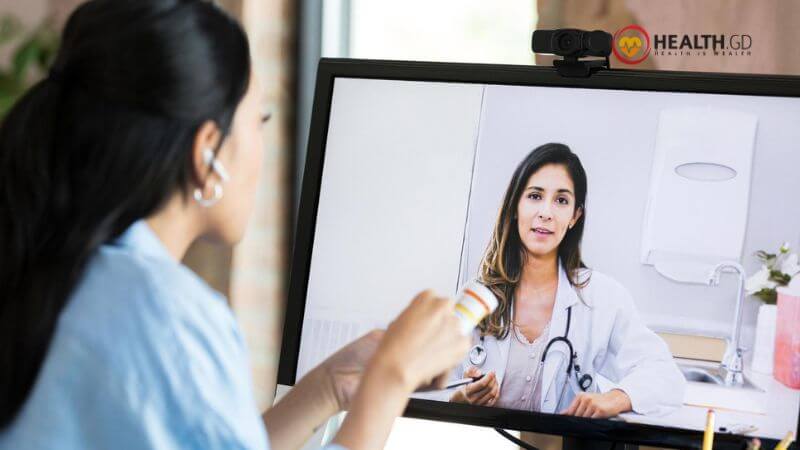Introduction
Telemedicine has transformed healthcare by providing remote medical treatments via digital platforms. Telemedicine has helped remove obstacles to reproductive healthcare, including abortion treatment.
The study examined 6,034 telehealth medication abortions from April 2021 to January 2022 in 20 states in three virtual clinics. Similar to in-person medication abortion trials, video and text sessions were successful and safe.
Telemedicine has improved abortion care availability, but it must address several major issues. These include legal and regulatory hurdles, abortion misinformation, stigma, and telemedicine abortion safety and efficacy.
Abortion Pill Access
Since 2008, US clinicians have offered telemedicine medication abortion services, but they became increasingly popular during the COVID-19 outbreak. FDA remarked it would no longer need an in-person visit for a practitioner to deliver the medications, allowing for more virtual appointments in areas where abortion and telemedicine are legal.
Whether using encrypted text or video calls, telemedicine for medication abortion is successful and safe, according to Thursday’s Nature Medicine research. Most research participants spoke with providers by text, but they may also phone or videoconference.
What Is An Abortion Pill?

FDA-approved abortion medicines end pregnancies after up to 10 weeks. Under medical supervision, people can safely take them home. Mifepristone blocks progesterone, which the body requires to stay pregnant. Misoprostol contracts the uterus, releasing pregnancy tissue.
Studies demonstrate pharmaceutical abortion is safe and effective, with over 95% success rates. Rare problems, such as excessive bleeding or partial abortion, may necessitate medical attention.
The pregnant person can use medication for abortion until 10 weeks after their last menstrual cycle. Individuals with specific health issues or a history of ectopic pregnancy, a rare occurrence where a fertilized egg implants outside the uterus, should avoid this.
Telemedicine is becoming more popular in reproductive healthcare, providing easy and discreet birth control, STIs, and abortion treatments.
Dr. Pratima Gupta, a San Diego abortion practitioner who was not part of the study, said the latest study helps prove the treatment is safe and successful. “It’s nice to have study evidence to confirm what we previously knew about medication abortion safety,”
A Healthcare Customer Survey
Advocates have long promoted telemedicine as a means to improve healthcare access in rural areas with few physicians due to its many purposes. According to KFF’s 2017 Women’s Health Survey, many women, particularly low-income women, postpone or avoid health treatment due to transportation or childcare issues, suggesting that telemedicine might benefit urban low-income populations.
A survey of healthcare customers found that 43% felt telehealth sessions would be less personal, and 49% thought the quality would be inferior. Telemedicine users may interact with several providers, disrupting the continuity of treatment.
Advantages of Telemedicine for Abortion

Telemedicine eliminates barriers to abortion treatment, such as distance, transportation, and provider shortages. Patients can remotely consult with doctors, receive advice and instructions, and get prescriptions.
According to the NIH, direct-to-patient telehealth (telehealth) may reduce abortion-related travel, but its function in helping individuals get a requested, timely abortion is unclear. A Pacific Northwest study found that telehealth abortion patients lived further from an abortion facility than those who received in-clinic care and that some chose telehealth even when a clinic was geographically convenient, indicating a preference for telehealth.
Telemedicine has the potential to increase access to abortion care, particularly in vulnerable areas where healthcare access is limited. Telemedicine helps healthcare doctors access rural, low-income, and abortion-restricted patients.
Regulatory Scene
Current Telemedicine Abortion Regulations
Telemedicine abortion regulations vary by state and nation. Telemedicine abortion is legal in certain places but restricted or banned in others.
You must know who benefits most from abortion models that allow patients to do everything at home. Few studies investigated whether patients choose telemedicine abortion when they have access to in-clinic abortion or if telehealth makes abortion possible, decreasing access obstacles. By treating patients at home, telemedicine reduces travel and work time. Remote consultation and medical delivery may save healthcare expenditures, especially for uninsured individuals.
Legal Battles and Policy Adjustments
Opponents of telemedicine abortion say it endangers patients and violates patient safety laws. Telemedicine abortion is safe and successful when administered according to evidence-based criteria, say proponents.
Telemedicine lets doctors track when and how patients take their medications. High-tech medical devices will let doctors monitor patients remotely.
Roles of Healthcare and Advocacy Organizations
Healthcare providers and advocacy groups are vital to expanding telemedicine abortion services and contesting restrictive legislation. Advocates can ensure safe and discreet abortion care for all by providing accurate information, training healthcare professionals, and mobilizing grassroots support.
Complete Screening and Evaluation
Telemedicine abortion providers carefully evaluate patients to ensure medication abortion eligibility and safety. This covers gestational age, contraindications, and medical issues.
Medication abortion patients get extensive counseling on the process, side effects, and follow-up. Healthcare practitioners get informed consent to assist patients in understanding their alternatives and making good decisions.
Aftercare and Support
Abortion patients can receive follow-up care and ask questions from telemedicine doctors. Patients learn what to expect after taking drugs and how to seek medical assistance.
Medication abortion problems are rare, but telemedicine providers have processes for treating emergencies and providing timely medical treatment. Local hospitals or emergency services can be contacted.
Clearing Up Misconceptions
Abortion patients may be afraid and confused due to misinformation and stigma. Telemedicine providers can dispel pharmaceutical abortion myths and provide factual information regarding its safety and legality.
Telemedicine abortion is equally safe as in-person abortion when done according to evidence-based standards. Telemedicine abortion has great patient satisfaction and few complications, according to studies.
Maintaining Privacy
Telemedicine abortion services use encrypted communication and data storage to protect patient privacy. Patients can be cared for at home without fear of criticism or the disclosure of personal information.
Telemedicine Abortion Services Have Positive Effects
Telemedicine abortion has transformed access to abortion care, especially for those from remote areas without transportation or stigma. Telemedicine abortion has great patient satisfaction and reaches underserved populations, according to research.
Patient and Doctor Testimonials
Patients and doctors have praised telemedicine abortion services. Telemedicine’s ease and privacy appeal to patients, while clinicians welcome the chance to reach underserved patients.
Telemedicine abortion providers follow WHO and ACOG norms. These guidelines include screening, counseling, medication prescribing, and follow-up best practices.
Patient Education and Empowerment
Enabling patients to make educated reproductive health decisions requires the correct information and resources. Telemedicine abortion providers enable patients to make healthcare decisions by providing complete knowledge and support. Healthcare providers, advocacy groups, and community groups must collaborate to increase telemedicine abortion services. Working together, stakeholders may remove structural obstacles to safe and discreet abortion care for all.
Telemedicine Innovations
Innovations in telemedicine, such as secure videoconferencing and computerized prescriptions, improve abortion treatment. These technologies allow healthcare practitioners to provide high-quality, patient-centered treatment wherever they are. Telemedicine abortion must remain inexpensive and accessible for all, say advocates. Advocates continue to campaign for the repeal of stringent regulations and telemedicine abortion services in underprivileged areas.
Conclusion
Medical abortion, or abortion pills, is a non-surgical way to end early pregnancies. This technique usually requires mifepristone and misoprostol. Reproductive healthcare is increasingly using telemedicine for consultations, medications, and follow-ups. Telemedicine makes abortion services discreet and accessible, especially for those with distance, clinic availability, or privacy issues. Telemedicine allows rural and underprivileged people to get abortion treatment. Remote consultation and medical distribution provide patient privacy, minimizing stigma.
Safe telemedicine abortion pill access is essential to reproductive healthcare, providing convenience and accessibility. Telemedicine may continue to promote reproductive health fairness and autonomy by enforcing safety standards, resolving concerns, and campaigning for policy improvements.


